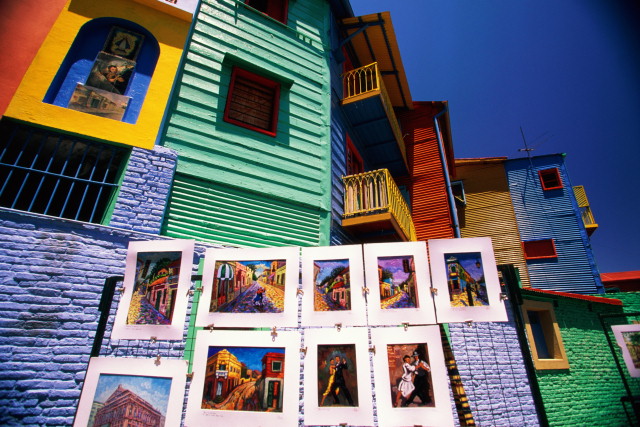Buenos Aires Real Estate - Español
La Boca achieved its name thanks to its geographical location in the opening of the Riachuelo river into the Rio de la Plata (Silver River) since the name means literally "the Mouth," or "the Opening."
In the time when the lands that today form the country of Argentina were still part of the Spanish colony, La Boca was the area where you could find black slaves living in preliminary constructions. In the independent era, it was a place where the "saladeros" (where they salted meat destined for exportation), but in the end of the 19:th century a large number of immigrants started arriving, mainly Italian, who were the ones that gave the area the appearance that it keeps to this day.
In 1882, due to a labor conflict, a strike was started and a group of Italians immigrants decided to make La Boca into an independent Republic. They signed an act in informing the Italian King that they had constituted the "República Independiente de La Boca" (Independent Republic of La Boca) and raised their flag. The General Julio Argentino Roca, who was then president of the Argentine Nation, went personally to the new country closely followed by his Army. He took down the raised flag and solved the problem, once again uniting La Boca to his territory.
The area is characterized by its low houses of channeled metal or wood painted in sharp colors and often constructed on top of pillars to protect them from the common floods caused but the Riachuelo river. Other particularities of La Boca are uneven side-walks (also raised to prevent flooding), old streets paved with stones, and its ship cemetery and naval warehouses.
The first real houses in La Boca were primarily constructed of wood with iron balconies. Even to this day some of these old houses remain standing, and they are truly what makes La Boca unique.
The sharp colors of the houses in La Boca are a result of the price of paint back then was very high. The people that worked in the harbor would take home the leftovers from their jobs and use every last drop in an attempt to paint the entire house in the same color. Don Benito Quinquela Martin was the first artist in La Boca to recognize this and used it to give special character and reality to his work. The paintings that later became well known gave the rest of the area the inspiration to copy the style, and it is possible that without Quinquela Martin La Boca wouldn't be the colorful neighborhood that it is today.
- Rentals and Sales of Houses, Apartments, Offices, Town House, and other Properties in La Boca.
- Real Estate La Boca.
- Sales, rentals, short term, commercial, student accommodation, holiday lets and apartment share.
- Owner reltals, Owner Sale,
- La Boca limits with the following areas: Barracas, San Telmo, and Puerto Madero.
-
Museo de Cera (Wax Museum)
Address: Del Valle Iberlucea 1261
The house dates back to the beginning of the 20:th century and was the place where the "Comité Socialista" (Social Committee) gathered headed by the Dr. Alfredo Palacios on those times.
Currently it is the place where the only wax museum in Argentina can be found, and the essence of the South of Buenos Aires can be experienced through epic scenes from their foundation to today. In five rooms the works of Domingo Tellechea, founder of the museum, are exposed.
-
Vuelta la Rocha
Address: Pedro de Mendoza Avenue and Del Valle Iberlucea intersection
Located on the side of the Riachuelo river, Don Antonio Rocha was the owner of these lands where today the small boat-shaped square can be found. It used the place where the Spanish immigrants congregated to remember their home land, and was then called "de los suspiros" (of the sighs).
-
El Pasaje Caminito (The Little Way Passage)
In the 1950's the local Arturo Cárrega decided that he wanted to recover the terrain that first had been a narrow creek, and later the rails of the train. He hired the painter Benito Quinquela Martín that named the 100 m long street "Caminito" (little way) after the title of the popular tango from 1926 by Peñalosa and Filiberto. The now neo impressionist styled passage started recieving donations from different artists such as Luis Perlotti, Roberto Capurro, A. Ibarra García, and Antonio Sassone, and in 1959 Caminito was converted into an open air museum. Every day between 10 am and 6 pm there is an art fair to the visitors pleasure.
-
Antiguo Puente Transbordador
Address: Pedro de Mendoza and Almirante Brown intersection
This iron structured bridge was inaugurated by the "Ferrocarriles del Sur" (Train company of the south) in 1914. The original bridge hung from a rigid cross-linking frame connected to the upper part. It was used for walking and by cars and trains to cross from the City of Buenos Aires into its province that starts on the other side of the Riachuelo river.
-
Estadio Boca Juniors (Boca Juniors Stadium)
Address: Brandsen 805
"La Bombonera," as the stadium is known, belongs to one of the two most popular soccer clubs in the whole of Argentina; Boca Juniors. (The other one is River Plate and their stadium can be found in Núñez). It has a capacity of 60.000 visitors and was inaugurated in the year of 1940. On the outer wall of the stadium, a mural painted by the artist Pérez Celis can be seen.
-
Cuartel de Bomberos Voluntarios (Voluntary Firefighters' Headquarter)
Address: Brandsen 567
The Voluntary firefighters of La Boca were created on 2 July, 1884 by Tomas Liberti. The men played a fundamental role during the time that the yellow fever swept over Buenos Aires and the various floods that have put the area under water due to the rise of water in the Riachuelo.


















